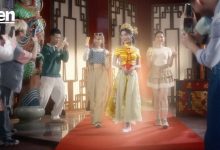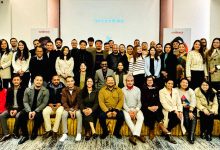“I used to be a graphic designer but what am I today?” Eric Cruz, Executive Creative Director of AKQA Shanghai, started his session by prompting this question. “Design is something that’s been within all of us since we were born up until now but for myself, it’s something I discovered when I was thirteen looking at album covers,” said Cruz at the adobo Design Series Asia held at The Mind Museum last March 22.
Cruz who was native Filipino born in San Juan, Manila moved to Apple Valley, California at just the age of twelve. His introduction to graphic design came by way of album covers and music.
In 1987, Cruz moved to Madrid, Spain. Unsure of what he really wanted to do and with his parents constantly reminding him not to go to art school, Cruz accidentally found an inspiration in an Asian-American man who was the Creative Director for Bloomingdales at that time. What inspired Cruz is how this man designed suits and ties, interiors of restaurants, and did this thing called advertising. He thought to himself, “If this man could do it, I’m gonna try to do what he does.” With this new-found inspiration, he had a clear vision of what he would like to be. “I knew nothing what about a Creative Director was until I learned about John Jay,” said Cruz.
From Madrid, Cruz landed in Hampton, Virginia where he studied Fine Arts. He then switched to Illustration because he “didn’t wanna solve other people’s problems” and then finally switched to Graphic Design. Being in this creative field which incorporates technology, art, and strategic thinking, Cruz said, “Graphic Design could do so many things; it opened up a whole new world for me.”
Cruz then moved to West Coast to study Interactive Design. “It was starting to split up into people who did design, people who did advertising, and people who did interactive but I sort of wanna do all of those,” he explained. “If you study design, you are simply the person who makes stuff look pretty; if you study art direction and advertising, you guys are the ones who come up with the ideas that’s gonna change the world,” he continued. “There was never this sort of hybridizing or coming together—form versus concept—and I could just never figure that out because I thought every designer should have an idea behind what they do.”
When Macintosh became known to the public and the Internet was first commercially launched in 1996, this was when Cruz came to realize that these digital tools have introduced new ways of expressing, designing, and creativity. He looks at this technological revolution as one of the greatest exploratory periods in time in terms of the visual realm.
With the Internet continuously reinventing the very world that people live in today, different studios came up and designers became in-demand. Cruz had a chance to work in Studio Archetype, an Architectural Visualization studio, and had worked for this man named Clement Mok who was the first user experience and user architect for Steve Jobs. Mok founded his own company and Cruz joined him that time and learned web designing.
Moving to Portland, Oregon and joining Wieden+Kennedy, Cruz did this thing called Microsoft. “There was a lot of exploration and experimentation that was happening in the visual field and what Wieden+Kennedy became known for is this brain foray in rethinking and redefining what advertising is,” he said.
Digital revolution, image-making and design happened when Wieden+Kennedy started collaborating with Graphic Designers all over the world doing Editorial Graphic Design. Cruz recalled that these Graphic Designers are the same people doing the album covers for Björk. This was also when he started seeing “a lot of stuff that didn’t look like advertising at the time.”
Eventually, there was a huge movement on how people define advertising through Graphic Design. After Wieden+Kennedy, Cruz moved to work to Imaginary Forces where he ended up working on the very first installment of the Spider-Man franchise. For him, one thing he learned from working in Imaginary Forces was how to set the world in motion through Graphic Design.
Years later, Cruz started working for AKQA Shanghai as an Executive Director. “China is where the future is happening faster than anywhere else in the world,” he said. With China aiming for global domination by 2020, Cruz explained, “This idea of the battle to win the future belongs to those who are brave enough to invent it.”
Going back to the question he prompted when he started his session, Cruz said, “I sort of realized that design is actually everything. It is not just about design, art direction, or being in digital; it’s now about honing but also experience, storytelling, innovation, future thinking, and most importantly, invention. This is what design is to me. I think as people and as a community, we need to think about design within a much bigger context of what we’re playing with today. It is not simply about asking someone to create a piece of illustration or typography or do a title to a movie. We have the power to basically redefine and reinvent the future that is going to be soon happening in front of our eyes.”
As design moves into new and uncharted areas, reaching deeper into core business processes and tackling emerging part of a company’s strategy to the focal point of its future, it’s true that it’s hard to figure out what the future of design will look like. Quickly-evolving tools and a shifting playing field will probably drive everyone’s lives ten years from now and people need to prepare for the world ahead.
“The new world needs new ways and new rules of thinking. We have to unlearn to learn new things and we have to remember that we are living in what is perhaps the most creative moment in the history of the planet which is now and it is up to us to take that opportunity,” Cruz said. “You have to give yourself to the present to create the future and invent tomorrow today.”
Before leaving the podium, Cruz left a question that challenged all of his listeners: “How will all of you contribute to that future?”









